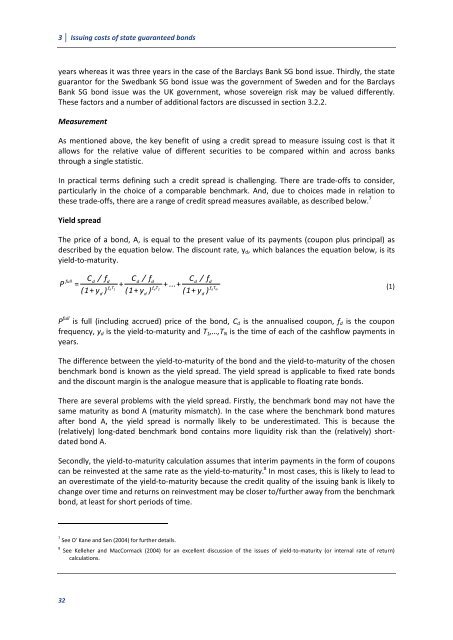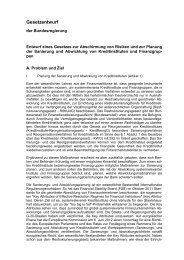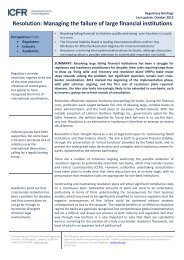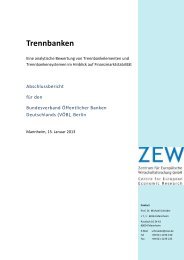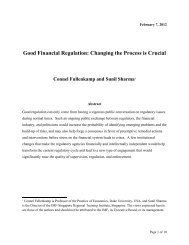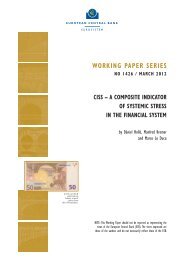3 Issuing costs of state guaranteed bonds - Financial Risk and ...
3 Issuing costs of state guaranteed bonds - Financial Risk and ...
3 Issuing costs of state guaranteed bonds - Financial Risk and ...
You also want an ePaper? Increase the reach of your titles
YUMPU automatically turns print PDFs into web optimized ePapers that Google loves.
3 <strong>Issuing</strong> <strong>costs</strong> <strong>of</strong> <strong>state</strong> <strong>guaranteed</strong> <strong>bonds</strong><br />
years whereas it was three years in the case <strong>of</strong> the Barclays Bank SG bond issue. Thirdly, the <strong>state</strong><br />
guarantor for the Swedbank SG bond issue was the government <strong>of</strong> Sweden <strong>and</strong> for the Barclays<br />
Bank SG bond issue was the UK government, whose sovereign risk may be valued differently.<br />
These factors <strong>and</strong> a number <strong>of</strong> additional factors are discussed in section 3.2.2.<br />
Measurement<br />
As mentioned above, the key benefit <strong>of</strong> using a credit spread to measure issuing cost is that it<br />
allows for the relative value <strong>of</strong> different securities to be compared within <strong>and</strong> across banks<br />
through a single statistic.<br />
In practical terms defining such a credit spread is challenging. There are trade-<strong>of</strong>fs to consider,<br />
particularly in the choice <strong>of</strong> a comparable benchmark. And, due to choices made in relation to<br />
these trade-<strong>of</strong>fs, there are a range <strong>of</strong> credit spread measures available, as described below. 7<br />
Yield spread<br />
The price <strong>of</strong> a bond, A, is equal to the present value <strong>of</strong> its payments (coupon plus principal) as<br />
described by the equation below. The discount rate, yd, which balances the equation below, is its<br />
yield-to-maturity.<br />
P<br />
P full is full (including accrued) price <strong>of</strong> the bond, Cd is the annualised coupon, fd is the coupon<br />
frequency, yd is the yield-to-maturity <strong>and</strong> T1,…,TN is the time <strong>of</strong> each <strong>of</strong> the cashflow payments in<br />
years.<br />
The difference between the yield-to-maturity <strong>of</strong> the bond <strong>and</strong> the yield-to-maturity <strong>of</strong> the chosen<br />
benchmark bond is known as the yield spread. The yield spread is applicable to fixed rate <strong>bonds</strong><br />
<strong>and</strong> the discount margin is the analogue measure that is applicable to floating rate <strong>bonds</strong>.<br />
There are several problems with the yield spread. Firstly, the benchmark bond may not have the<br />
same maturity as bond A (maturity mismatch). In the case where the benchmark bond matures<br />
after bond A, the yield spread is normally likely to be underestimated. This is because the<br />
(relatively) long-dated benchmark bond contains more liquidity risk than the (relatively) shortdated<br />
bond A.<br />
Secondly, the yield-to-maturity calculation assumes that interim payments in the form <strong>of</strong> coupons<br />
can be reinvested at the same rate as the yield-to-maturity. 8 In most cases, this is likely to lead to<br />
an overestimate <strong>of</strong> the yield-to-maturity because the credit quality <strong>of</strong> the issuing bank is likely to<br />
change over time <strong>and</strong> returns on reinvestment may be closer to/further away from the benchmark<br />
bond, at least for short periods <strong>of</strong> time.<br />
7<br />
See O' Kane <strong>and</strong> Sen (2004) for further details.<br />
8<br />
See Kelleher <strong>and</strong> MacCormack (2004) for an excellent discussion <strong>of</strong> the issues <strong>of</strong> yield-to-maturity (or internal rate <strong>of</strong> return)<br />
calculations.<br />
32<br />
full<br />
Cd<br />
/ f<br />
=<br />
( 1+<br />
y<br />
d<br />
fdT1<br />
d )<br />
Cd<br />
/ f<br />
+<br />
( 1+<br />
y<br />
d<br />
f T<br />
d )<br />
d 2<br />
C / f<br />
+ ... +<br />
( 1+<br />
d d<br />
fdTN<br />
yd<br />
)<br />
(1)


